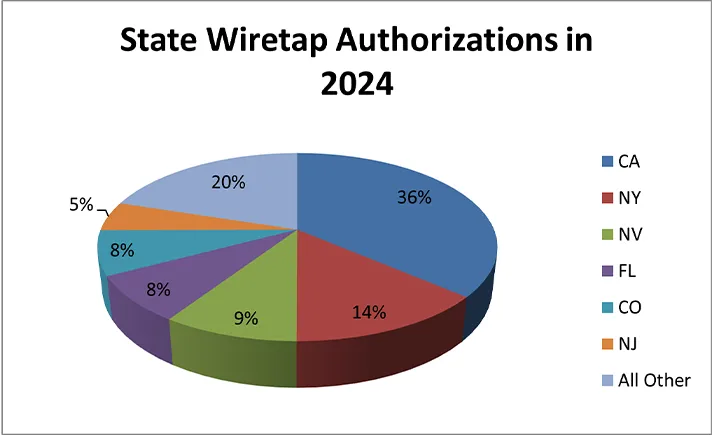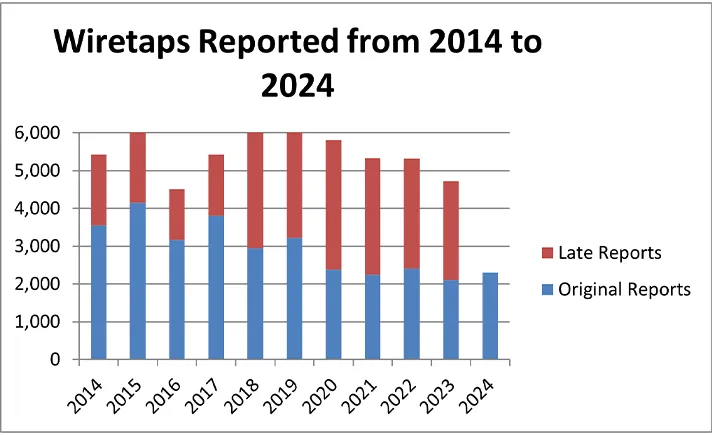This report covers wiretaps concluded between January 1, 2024, and December 31, 2024, that were reported properly to the Administrative Office of the U.S. Courts.1 This report also provides supplementary information reported to the AO on arrests and convictions resulting from wiretaps concluded in prior years
Forty-nine jurisdictions (the federal government, the District of Columbia, the Virgin Islands, Puerto Rico, and 45 states) currently have laws that authorize courts to issue orders permitting wire, oral, or electronic surveillance. Table 1 shows that a total of 24 jurisdictions (including state and federal entities) reported using at least one of these types of surveillance as an investigative tool during 2024.
Summary and Analysis of Reports by Judges
The number of federal and state wiretaps reported in 2024 increased 9 percent from 2023. A total of 2,297 wiretaps were reported as authorized in 2024, with 1,290 authorized by federal judges and 1,007 authorized by state judges. Compared with the applications approved during 2023, the number approved by federal judges increased 14 percent in 2024, and the number approved by state judges increased 4 percent.
In 23 states, a total of 116 separate local jurisdictions (including counties, cities, and judicial districts) reported wiretap applications for 2024. Applications concentrated in six states (California, New York, Nevada, Florida, Colorado, and New Jersey) accounted for 80 percent of all state wiretap applications.

Seventy-five federal jurisdictions submitted reports of wiretap applications for 2024. The District of Colorado authorized the most federal wiretaps, approximately 8 percent of the applications approved by federal judges.
Federal judges and state judges reported the authorization of 402 wiretaps and 156 wiretaps, respectively, for which the AO received no corresponding data from prosecuting officials. Wiretap Tables A-1 and B-1 (which are available online at http://www.uscourts.gov/statistics-reports/analysis-reports/wiretap-reports) contain information from judge and prosecutor reports submitted for 2024. The entry “NP” (no prosecutor’s report) appears in these tables whenever a prosecutor’s report was not submitted. Some prosecutors may have delayed filing reports to avoid jeopardizing ongoing investigations. Some of the prosecutors’ reports require additional information to comply with reporting requirements or were received too late to include in this document. Information about these wiretaps should appear in future reports.
Wiretap Orders, Extensions, and Locations
Table 2 presents the number of wiretap orders issued in each jurisdiction that provided reports, the number of extensions granted, the average lengths of the original periods authorized and any extensions, the total number of days in operation, and the locations of the communications intercepted. Federal and state laws limit the period of surveillance under an original order to 30 days. This period, however, can be lengthened by one or more extensions if the authorizing judge determines that additional time is justified.
During 2024, the average reported length of an original authorization was 30 days, the same as in 2023. The average reported length of an extension was also 30 days. In total, 1,600 extensions were reported as requested and authorized in 2024, an increase of 15 percent from the prior year. The Western District of Texas (TX-W) conducted the longest federal wiretap that was terminated in 2024. One original order in TX-W was extended 7 times to complete a 212-day wiretap used in a narcotics investigation. An order in the Western District of New York was extended 6 times to complete a 209-day wiretap in a fraud investigation. For state intercepts terminated in 2024, the longest wiretap occurred in Queens, New York, where an original order was extended 24 times to complete a 683-day wiretap used in a narcotics investigation.
Most orders reported in 2024 did not specify the location of the communication intercepted. Given that the location of a mobile telephone can change, the most commonly reported communications intercepted where the location was not specified were made using cellular or mobile telephones. In 2024, a total of 96 percent of all authorized wiretaps (2,216 wiretaps) did not specify the location of the communication intercepted.
Criminal Offenses
Drug offenses were the most prevalent type of criminal offenses investigated using reported wiretaps. Table 3 indicates that 49 percent of all applications for wiretaps (1,115 wiretap applications) in 2024 cited narcotics as the most serious offense under investigation. Applications citing narcotics combined with applications citing other offenses, which include other offenses related to drugs, accounted for 80 percent of all reported wiretap applications in 2024. Conspiracy, the second-most frequently cited crime, was specified in 10 percent of applications. Racketeering, the third-largest category, was specified as the most serious offense in approximately 5 percent of applications. Many applications for court orders revealed that multiple criminal offenses were under investigation, but Table 3 includes only the most serious criminal offense listed on an application.
Lengths and Numbers of Wiretaps
In 2024, reported installed wiretaps were in operation for an average of 47 days, 2 days longer than the average in 2023. The federal wiretap with the most intercepts occurred during a conspiracy investigation in the Eastern District of Louisiana and resulted in the interception of 2,084,741 messages in 59 days. The state wiretap with the most intercepts was a 390-day wiretap for a larceny investigation in New York, which resulted in the interception of 475,779 messages. See Table A-1 and Table B-1 for data on lengths and numbers of intercepts.
Encryption
The number of state wiretaps reported in which encryption was encountered increased from 238 in 2023 to 258 in 2024. In 220 of these wiretaps, officials were unable to decipher the plain text of the messages. A total of 350 federal wiretaps were reported as being encrypted in 2024, of which 313 could not be decrypted.
Cost of Wiretaps
Table 5 provides a summary of expenses related to wiretaps in 2024. The expenditures noted reflect the cost of installing wiretap devices and monitoring communications for the 1,084 authorizations for which reports included cost data. The average cost of a wiretap in 2024 was $80,730, down 95 percent2 from the average cost in 2023. In San Joaquin, California, the cost of a 30-day state wiretap conducted to investigate an “other” offense that resulted in 75 arrests totaled $843,784. For federal wiretaps for which expenses were reported in 2024, the average cost was $111,725, a 6 percent increase from 2023. The wiretap with the largest reported cost occurred in the Eastern District of California, where the cost of a 30-day federal wiretap in an illegal drugs investigation totaled $1,100,000.
Methods of Surveillance
The three major categories of surveillance are wire, oral, and electronic communications. Table 6 presents the type of surveillance method used for each wiretap installed. The most common method reported was wire surveillance, which accounted for 47 percent (815 cases) of the intercepts installed in 2024.
Arrests and Convictions
Data on individuals arrested and convicted as a result of wiretaps reported as terminated is presented in Table 6. As of December 31, 2024, a total of 5,463 persons had been arrested (down 1 percent from 2023), and 717 persons had been convicted (up 57 percent from 2023). Federal wiretaps were responsible for 49 percent of the arrests and 38 percent of the convictions arising from wiretaps for this period. The Western District of Pennsylvania reported the most arrests for a federal district in 2024, with wiretaps there resulting in the arrest of 439 individuals. The Southern District of Alabama reported the most convictions for a federal district in 2024, with wiretaps there resulting in the conviction of 46 individuals. State wiretaps were responsible for 51 percent of the arrests and 62 percent of the convictions arising from wiretaps for this period. The Seventh Judicial Circuit of Florida reported the largest number of arrests (699) and convictions (281) arising from a state wiretap in 2024.
Summary of Reports for Years Ending December 31, 2014, through December 31, 2024
Table 7 presents data on wiretaps requested and authorized each year from 2014 to 2024. Total authorized intercept applications reported by year decreased 35 percent from 3,554 in 2014 to 2,297 in 2024. Most wiretaps during that period were used for narcotics investigations, which accounted for 61 percent of intercepts authorized in 2014 (2,107 applications) and 49 percent in 2024 (1,115 applications). Table 9 presents the total number of arrests and convictions resulting from intercepts terminated in calendar years 2014 through 2024. It includes data on wiretaps conducted in 2024 as well data on wiretaps conducted previously but reported in later years. This data also is represented in the chart below.

Supplementary Reports
Under 18 U.S.C. § 2519(2), prosecuting officials must file supplementary reports on additional court or police activity occurring as a result of wiretaps reported in prior years. Because many wiretap orders are related to large-scale criminal investigations that cross county and state boundaries, supplemental reports are necessary to fulfill reporting requirements. Arrests, trials, and convictions resulting from these interceptions often do not occur within the same year in which the intercepts are first reported. Table 8 shows that 2,175 arrests, 890 convictions, and additional costs of $7,175,405 arose from and were reported for wiretaps completed in previous years. Forty-eight percent of the supplemental reports of additional activity in 2024 involved wiretaps terminated in 2023. Wiretaps concluded in 2023 led to 63 percent of arrests, 41 percent of convictions, and 55 percent of expenditures noted in the supplementary reports.
1Reports of wiretaps submitted to the AO using forms WT-2A or WT-2B that passed all of the AO’s data quality checks were considered complete data submissions and are included in the Wiretap Report. When reports failed the AO’s data quality checks and thus were not complete data submissions, the wiretaps reported were not entered into the AO’s database, as the reports raised data quality issues significant enough to interfere with the AO’s ability to process the report. Reports of wiretaps that are not complete data submissions are not included in the Wiretap Report.
2The decrease in the average cost occurred because last year wiretaps in Suffolk, New York, had a total reported cost of $4.5 billion.
